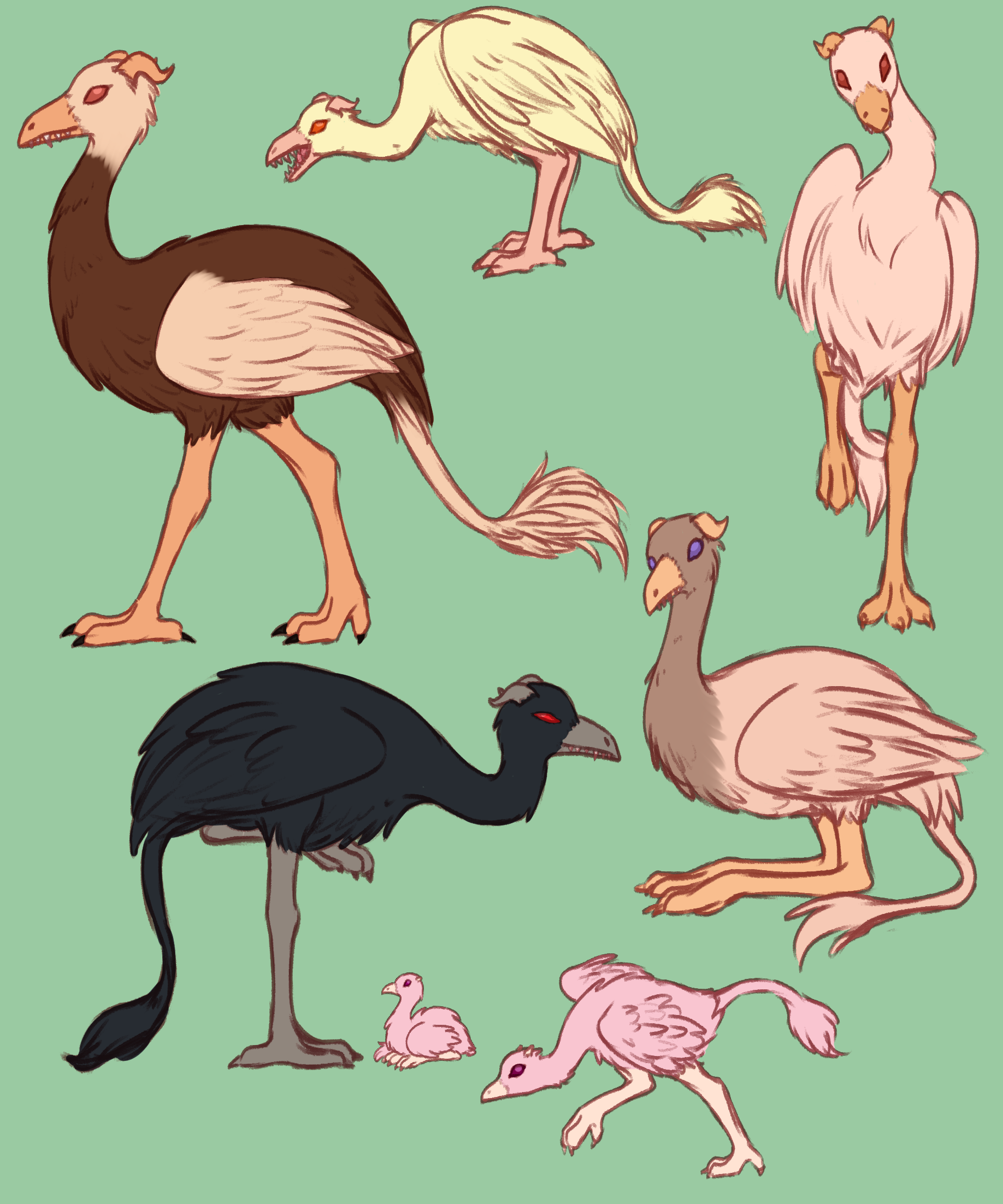Birigon
"When on the road, your Birigon is your closet companion. Just you and the open skies. I was 15 when my parents bought me this gorgeous coffee colored chick. I've raised her since she was a baby and now Mocha is like my best friend. She's the only one who will put up with me for more than a day."
Basic Information
Anatomy
Birigon are a small species of Dragon with feathers and other bird-like features. The resemble known creatures like ostriches or the ancient archaeopteryx.
Though they are small for a dragon, they are sill quite large, being larger than most horses and standing at almost 9 feet. The have large backs and strudy muscular legs that allow them to easily carry a person. They're massive wings allso allow them to take flight even with a passenger.
Birigon snouts resemble beaks as they lack feathers. Their mouths are full of sharp fangs they use to chop down and tear prey apart. Their long talons also aid in catching and killing prey. Both males and females grow large horns on their hair that curve in an a S shape, that are used for ramming larger creatures in threatening situations.
Their heads are attatched to long, flexible necks which allows them to see at many angles with out moving from their spot. They also have a long feathered tail that helps them balance when they are running or taking flight.

Coloration
Birigon have been bred to have a more varied coat palette, and can come in a wide variety of colors. Breeding has also preferred birigon with less aggressive temperaments.
by IbbyWondrous
Genetics and Reproduction
Birigon mothers will lay up to 3 or 4 eggs every breeding season. If the eggs aren't fertilized, they are typically taken and used for food. If they are fertilized, the eggs will have splotch like markings to indicate so. The splotches usually indicate the coloration of the baby, making breeding easy.
The mother will usually watch over her eggs until they hatch, and then care for the hatchlings for a short period of time.
Non fertalized eggs tend to have fragile shells, while fertilized eggs will grow a thicker layer of shell to protect the baby.
Growth Rate & Stages
Birigon are born with feathers, however not all of them. They will tend to have very patchy feather growth upon hatching. By the time the rest of their feathers grow, they are usually old enough to be independent of their mother.
In domesticated Birigon, its common for eggs to be sold to aspiring Birigon owners, where it is their job to care for and raise the hatchling. This is because birigon are notoriously hard to train if not used to humans at an early age. A birigon owner has to form a bond with their dragon for then to work together efficiently.
It takes about five or six years for a birigon to reach maturity and they are not ridable until then, so taking in a chick is a big commitment.
Ecology and Habitats
Birigon can live in most conditions, even though they are native to the deserts of A'ramel Alshiu, where you'll find many wild Birigon wandering the sands.
It's a good idea however to try to keep them warm. Birigon are harder to care for in colder regions, and the cold weather will often mess up their breeding patterns, meaning eggs often have to be imported from warmer regions.
Dietary Needs and Habits
Birigon are carnivores and eat small mammals and birds such as chickens, foxes or rabbits. It's recommended to keep Birigon away from other pets like cats or small dogs, as it's likely the Birigon will try to eat them.
Biological Cycle
Birigon will molt feathers once a year during the warmer season. They will often spend a lot of that time preening to get the excess feathers out.
Additional Information
Perception and Sensory Capabilities
Birigon have large eyes that give it excellant eyesight for hunting. It also has a very strong since of smell. It's hearing is not so great and they usually only respond to loud sounds like yelling or whistling. More often commands need to be touch based for them to be effective.
Global Announcment
NEW!! [7/23/21] Open AnnouncementMirror Link
Fantasme Imagination is being mirrored on BlueWondrous Wiki, so feel free to check that out too.
Genetic Ancestor(s)
Scientific Name
Draco plumaequus
Lifespan
40-50 years
Average Height
9ft - 9'6ft
Average Weight
270-300lbs





They look so cuuuuuute!! I want one now! ^^ The formatting and art is what stood out to me the most, it made the article a breeze to read through and very digestible. Other than that, I really like how detailed they are, the splotched eggs and patchy feathers especially, I can' help but smile imagining a babby birigon with patches of feathers. Cool article!!